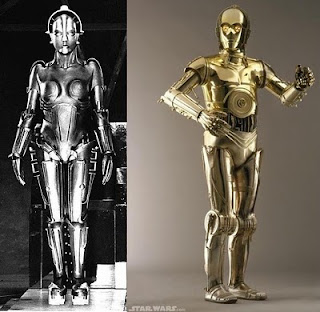The War of the Worlds (1897, 1898, 1938, 1953...)
“…vast and cool and unsympathetic…”
While these words may sound like a description of Hoth, they
are actually describing Martian invaders...
Much has been written about and inspired by H.G. Wells’ The
War of The Worlds. It was one of the first stories to lay out an alien invasion
of Earth – a concept keeps popping up in science fiction from Radar Men from the Moon to Close Encounters of the ThirdKind to Robotech.
The War of the Worlds first appeared in serialized form in
both UK and US magazines in 1897. A year later, the entire tale was released as
a book for the first time.
In 1938, it was retold in Orson Welles’ Mercury Theatre radio program. The broadcast was mistaken for an actual news report of a Martian
invasion by many Americans – including my own grandmother who feared Martians abducted her twin sister when she failed to come home before curfew that late October night.
1953 brought the George Pal film production of the Martian
invasion with a sinister-looking alien, sleek Martian machines (with killer
sound effects for the Heat Ray) and the captivating Sylvia Van
Buren - portrayed by the beautiful Ann Robinson. Robinson would later make cameos in the
1988-1989 War of the Worlds TV series and the 2005 Steven Speilberg/Tom Cruise
remake.
Ever since 1980, I heard The War of the Worlds referred
to as an inspiration for The Empire Strikes Back. While I appreciated the
intergalactic battle aspect of both films, I once struggled with the comparison. And that really bothered me, since I have been just as big
a fan of War of the Worlds as I have been of Star Wars. The seemingly obvious
connection was the Martian invasion of Earth to the Imperial assault on Hoth.
The part that tripped me up was that the Martian “fighting
machines” – also referred to in the classic book as “tripods” – didn’t look
anything like the Imperial Walkers (a.k.a. AT-ATs) in Empire. This was especially
the case in the aforementioned 1953 movie where the Martian machines didn’t
even have visible legs (but an awesome design nonetheless)…
Isn’t this 1955 rendering of the Humans vs. Martians remind
you of rebel troopers struggling in the Hoth trenches as the massive Imperial
walkers conduct their attack
on Echo Base?
Besides the visual comparison, think of this thematically.
In Wells’ original story, the Martians land in the UK’s sand pits of Horsell
Common. They attack the nearby large town of Woking and move their invasion
onto various parts of the civilized world.
At the time of the first publication of The War of the Worlds, the
British Empire was spread out through the real world. By placing the UK under the
attack of superior war machines/Martian oppressors, Wells was turning the
tables on the British. The real-life, worldwide oppressors were now forced to
see life as the oppressed under the might of an off-world Empire.
In The Empire Strikes Back, the Imperials land in the ice
fields outside the Rebels’ Echo Base (presumably the only civilization on the
ice planet) and attack the rebels head on. It is quite clear that the Imperials
have superior technology with Luke Skywalker’s comment “That armor’s too strong
for blasters…” and whatnot. The rebel underdogs are fighting for the oppressed
across the galaxy, but they are no match for such well-equipped Imperial foes.
I find it also quite delicious that the AT-ATs are commanded
by the British-sounding Imperial officers (once again, the tables are turned –
the oppressed British in Wells’ tale are the oppressors in Lucas’ movie).
The beginning of these two “invasion” tales are the same: a
mistaken meteorite hits “the ground near here” (as Luke puts it) and winds up
being the first step in a full-fledged invasion. However, the final outcomes of
each invasion are completely different. And that’s what makes these classic
film comparisons so much fun. It’s so cool to see what Lucas borrowed from
certain established stories…and left behind, too.




Comments
Post a Comment